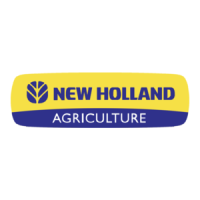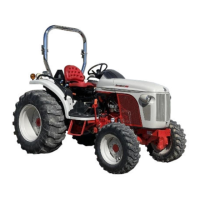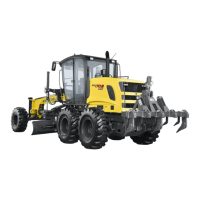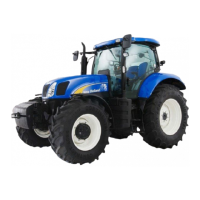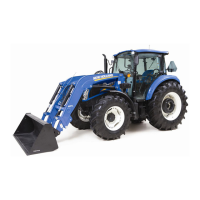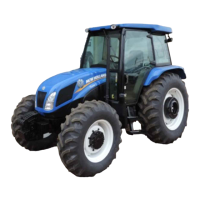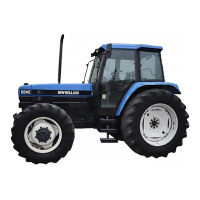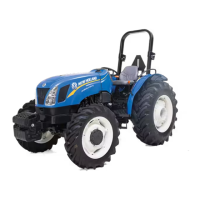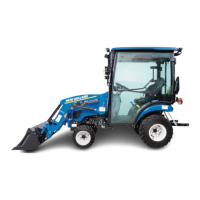1 - GENERAL INFORMATION
Tractor intended use
WARNING
Roll-over hazard!
Always pull from the drawbar. DO NOT attach chains or ropes to the Roll Over Protective Structure
(ROPS) for pulling purposes, as the machine could tip over. When driving through door openings or
under low overhead objects, make sure there is sufcient clearance for the ROPS.
Failure to comply could result in death or serious injury.
W0463A
Your tractor is designed and made to pull, to carry, and to power a variety of mounted or towed equipment, although
within some physical limits. The working speed and performance may depend on a number of various parameters,
such as weather and terrain conditions. Though the tractor is designed to perform in combination with a variety of
equipment in most crops and conditions, there may be a number of combinations of above parameters, for which there
is severe degradation of performance of the tractor and/or its mounted or trailed equipment. If you notice degradation
of performance, contact your dealer for assistance. He may have useful information for improvements, or a kit may
be available to enhance the performance.
•
Do not use the tractor for another purpose than intended by the manufacturer and outlined in this manual.
•
Do not use the tractor beyond its limits of terrain gradient and stability as outlined further in this manual. Using the
tractor beyond these limits may result in roll-over or tip-over. Observe the recommendations in this manual.
•
Use only approved accessories and attachments that are designed for your machine. Consult your dealer on
changes, additions or modications that may be required for your machine. Do not make any unauthorized modi-
cations to your machine.
•
Do not use the tractor on higher speeds than allowed by the load and the environment. A wet surface or other low
adherence conditions may increase the braking distance or result in vehicle instability. Always adapt your traveling
speed according to the load of the vehicle and the characteristics of the road.
•
Do not use the tractor near or on soft verges of canals and brooks or banks and verges that are undermined by
rodents. The tractor may sink sideways and roll-over.
•
Do not use the tractor on brittle bridge heads and poor bridge oors. These constructions may collapse and cause
roll-over of the tractor. Always check out the condition and carrying capacity of bridges and ramps prior to engage.
•
Do not use the tractor without wearing the seat restraint system during activities where roll-over or tip-over hazards
exist. The Roll Over Protection Structure (ROPS) cab or ROPS structure will only be fully effective when the driver
remains attached to his seat.
•
Do not use equipment mounted on the tractor which is not correctly matching and rmly xed. Such equipment may
increase the risk for roll-over and hit the tractor when coming loose. Ensure that the dimensions of the three-point
linkage interface of both the tractor and the equipment are matching according to the categories dened in ISO
730. Ensure that the dimensions and speed of the Power Take-Off (PTO) shaft on the tractors are matching those
of the equipment.
•
Do not use the tractor in combination with equipment, without having consulted the specic operator’s manual
provided with the equipment. The tractor is a universal tool to carry, tow, and drive a variety of equipment. This
manual alone cannot provide you with all the information required for the safe operation of the combination.
•
Do not use the tractor beyond its limits of dynamic stability. High speed, abrupt maneuvers, and fast and short
cornering will increase the risk of roll-over.
•
Do not use the tractor for pulling work, in cases where you do not know whether the load will yield, for instance
when pulling stumps. The tractor may ip over when the stump is not yielding.
•
Be cautious that the center of gravity of the tractor may increase when loads on the front-end loader or the three-
point linkage are raised. In these conditions, the tractor may roll-over earlier than expected.
•
Do not step down from the tractor without shutting down the PTO, shifting the transmission to park or neutral and
applying the park brake, unless continued PTO operation is required for some equipment, such as pumps or wood
chippers. The latter equipment may have an emergency stop device on the equipment itself, as human intervention
is needed during operation. But other equipment, engaged and driven by the tractor will have no means to stop the
power transmission, other than the PTO clutch of the tractor.
•
You shall take the necessary precautions to always be aware of the possible presence of bystanders, certainly when
maneuvering in conned areas, such as the farm yard and sheds. Keep people away from the tractor during work;
ask bystanders to leave the eld. There is not only the risk to be overrun by the tractor, but objects ejected by some
1-2
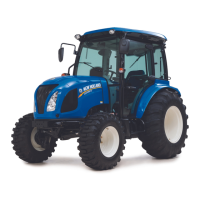
